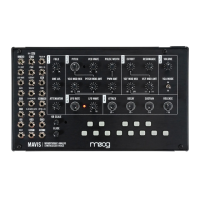29 | The Envelope Generator (EG)
ENVELOPE PARAMETERS
TIP: In order to explore the EG controls, be sure the VCA MODE switch is set to EG. Press any key on the
keyboard to trigger new envelopes as you explore dierent settings of these parameters.
ATTACK (Attack Time)
The ATTACK knob determines the amount of time required for the control
signal to rise from zero to its maximum level once a key is pressed. Rotating
this knob counterclockwise will create a faster Attack time (0.8 ms minimum.)
Rotating this knob clockwise will create a slower Attack time (5.5 seconds
maximum). Faster attacks are useful for creating plucked sounds, while
slower attacks are more useful for creating bowed string sounds and swells.
DECAY (Decay Time)
The DECAY knob determines the amount of time required for the control
signal to fall from the maximum level achieved by the Attack stage to the
Sustain level, while a key is being held. Rotating this knob counterclockwise
will create a shorter Decay time (3.0 ms minimum.) Rotating this knob
clockwise will create a longer Decay time (18 seconds maximum). Short
decay times are useful for creating articulated lead notes, while longer decay
times allow a note to fade slowly into the Sustain level.
SUSTAIN (Sustain Level)
The SUSTAIN knob is unique, in that it determines a level, not an amount
of time. Once the Attack and Decay stages are complete, the control signal
will remain at the level set by the SUSTAIN knob for as long as a key is
held. Rotating this knob counterclockwise will provide a lower sustain level.
Rotating this knob clockwise will create a higher sustain level. The range of
this Sustain level—in terms of control voltage—extends from 0 V–8 V.
RELEASE (Release Time)
The RELEASE knob determines the amount of time required for the control
signal to fall from its Sustain level to zero once a key is released. Rotating
this knob counterclockwise will create a shorter Release time (3.0 ms
minimum.) Rotating this knob clockwise will create a longer Release time
(18 seconds maximum). Shorter settings are good for classic funk basses
that end abruptly, while longer settings are good for creating smooth
musical tails that ring out over time.

